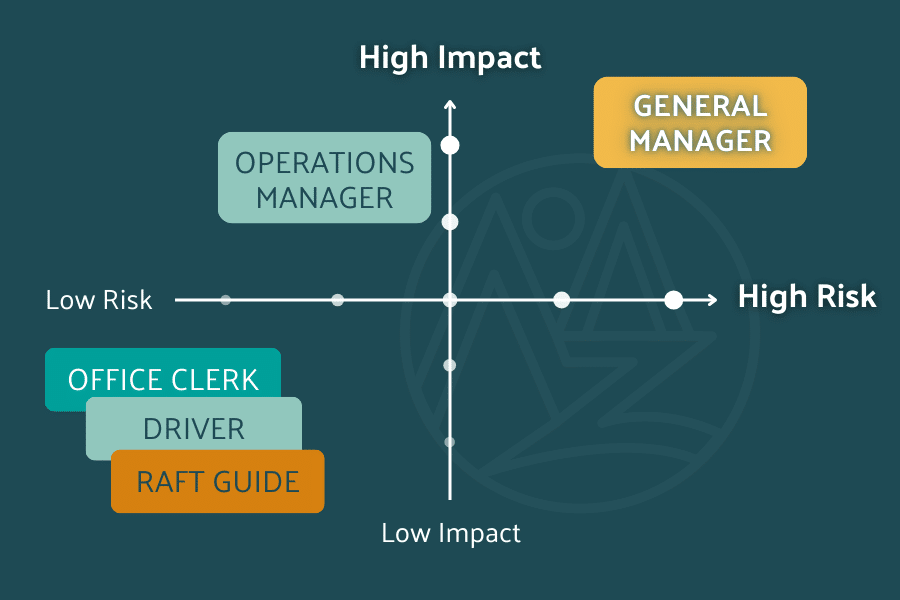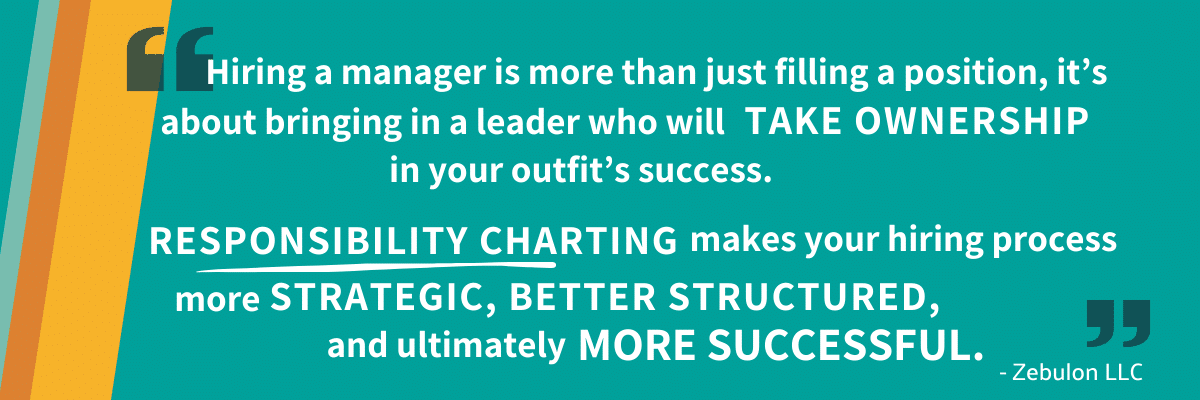In the market for hiring a great manager? Welcome to the club!
Bringing someone into an outfitting leadership role requires more than just finding the right personality with relevant experience. It means using a structured, intentional approach to set them – and you – up for success.
As such, one of the most effective (yet often overlooked) tools in the manager hiring process is responsibility charting.
‘Tis the Season – Time to Hire a Manager
For many outfitters, hiring season is a cycle that repeats like clockwork. At the time of this article’s publication (mid-February), many folks in our industry are knee-deep in the hiring process to get their business in tip-top shape for the summer season.
We see it over and over: businesses invest the bulk of their energy into recruiting boat-loads of front-line seasonal staff, like first- and second-year guides. While these are indeed important hires, putting all your energy into these lower-impact roles means insufficient energy is left over to intentionally hire good leaders.
If you’re putting the same amount of time and energy into hiring managers as you are hiring first-year guides, read on to discover our tried-and-true process of responsibility charting.
High Impact/High Risk
Leadership roles are both high impact and high risk. To paint a better picture for you, imagine plotting your company’s roles on an axis of impact vs. risk:
- A low impact, low risk role (like a guide, driver, or an office clerk) doesn’t need extensive pre-hire planning
- A high impact, high risk role (like a general manager) should involve far more intentionality in hiring and onboarding

Ready to recruit a high-impact, high-performing manager? First, you want to ensure you’re putting enough time, energy, and care into making the right choice.
What Workers Want Today: A Roadmap for Retaining Great People
A solid recruitment plan isn’t just about attracting good candidates. A solid recruitment plan includes keeping new hires engaged and showing them clear paths for growth, so they’ll want to stick around long-term.
If you haven’t heard yet, today’s workforce expects more than just a paycheck. Research consistently shows that employees, especially those in leadership roles, value:
- Growth and development opportunities
- A sense of purpose
- Workplace satisfaction
- Well-defined expectations and responsibilities
The good news? These are not particularly expensive or difficult things to provide. But they do require commitment on your end.
The really good news? Responsibility charting is a great way to ensure any new manager you hire experiences these ultra-important factors from day one, setting them up for long-term success.
Responsibility Charting is the Key to a Smooth Hiring Process
So, how do you preemptively provide the clarity and structure good managers thrive in? And how do you make sure you’re hiring someone who’s a good fit for the tasks you really need handled? Enter responsibility charting.
Responsibility charting may look like a big chore list, but in reality, it’s a structured method of defining roles and clarifying expectations. If you’re unfamiliar with the nuts & bolts of the process, check out our previous article on responsibility charting for a deep dive into the process.
To put it simply, responsibility charting helps:
- Clearly define job roles before you even write the job description
- Determine which tasks you should delegate off your plate, and onto someone else’s
- Create accountability so everyone, veterans and new hires alike, know what’s expected of them
- Foster collaboration and communication, so everyone understands their colleagues’ responsibilities
After charting responsibilities, this means you’ll be better prepared to:
- Write an accurate job description
- Conduct more effective interviews
- Support new hires through structured expectations and feedback
Two Actionable Recruitment Tools from Responsibility Charting
Responsibility charting can feel like a heavy lift, especially if you’re doing it for the first time. However, two immediate and powerful recruitment tools come out of responsibility charting, which improve how you attract, hire, and retain managers.
Recruitment Tool #1: A Clear List of Responsibilities
One of the biggest hiring faux-pas is writing vague job descriptions that don’t truly reflect the role. Another big “no-no” is simply recycling your job postings from previous years. Responsibility charting solves these problems.
Before posting a job, take the time to go through the responsibility charting process with your current leadership team. The result? A crystal-clear list of duties and expectations. You’ll also have an itemized list of tasks your new hire should expect to shoulder (and the team members earmarked to train them up).
This list serves multiple purposes:
- It forms the foundation of a high-quality job description
- It helps weed out candidates who aren’t the right fit
- It provides a roadmap for accountability during the manager’s trial period
Speaking of the trial period: new managers are most likely to struggle (or quit) during their trial period if expectations are unclear. By using the “responsibility chart-turned-job-description” as a guiding document, you can ensure new managers are on track, aligned with their role, and growing in the position, all during that crucial starter period.
Recruitment Tool #2: Clear Pathways for Growth
One of the biggest challenges in outfitter businesses is employee retention. If a new manager doesn’t see a future in your company, or if they simply aren’t clear on what exactly you expect of them, they might be off chasing other waters before next season.
Responsibility charting helps prevent turnover by laying out clear pathways for personal and professional growth. It can also be used to articulate your vision for your broader outfit and the individual hired. These are key motivators for many mid-20’s managers in our industry, as articulated by Dr. David Yeager, PhD in his recent book “10 to 25: The Science of Motivating Young People.” (Do yourself – and your managers – a favor and read that book!)
By charting responsibilities collaboratively with your top managers and leadership team, you:
- Create transparency in how work is distributed
- Identify future delegation opportunities for growth-minded employees
- Allow new managers to be “in the room where it happens,” so they can learn about your business priorities first-hand
Instead of having ambiguous jobs with undefined responsibilities, your entire team will see where they fit in this season – and visualize how they can grow in future seasons.

Hire Smart for Long-Term Success
Hiring a manager is more than just filling a position, it’s about bringing in a leader who will take ownership in your outfit’s success. Responsibility charting makes your hiring process more strategic, better structured, and ultimately more successful.
If you’re ready to take hiring to the next level and set your managers up for success, start by charting your team’s responsibilities. And if you want to go even deeper into leadership best practices, and gain an added level of accountability when it comes to Responsibility Charting and more, consider joining The Eddy, our subscription leadership peer group.




